The transient’s key findings are:
- Millennials began their careers in weak labor markets, so initially they lagged behind Late Boomers and Gen Xers on the identical ages in life occasions and wealth.
- Strikingly, information for 2022 present a giant reversal: Millennials had caught up on most indicators, they usually surpassed earlier cohorts in wealth accumulation.
- The principle cause was an enormous runup in housing wealth, which soared throughout COVID, however beneficial properties in monetary wealth additionally boosted stability sheets.
- It’s not clear, nonetheless, what this excellent news means for retirement safety, since home costs could reverse and few retirees faucet their fairness for consumption.
Introduction
The discharge of the Federal Reserve’s 2022 Survey of Client Funds affords an opportunity to compensate for the retirement saving of Millennials – these born throughout 1981-1999. This group, regardless of being extra educated than earlier cohorts, confronted early challenges, as many left faculty with massive scholar loans and started their careers within the powerful job market following the bursting of the dot.com bubble and the Nice Recession. These components delayed main life milestones, corresponding to getting married and proudly owning a house, and restricted their potential to build up wealth. Our preliminary 2016 snapshot confirmed Millennials manner behind earlier cohorts, on the identical ages, on each dimension.1
Our subsequent check-in with Millennials was 2019.2 After three years of a powerful economic system simply previous to the pandemic, this cohort had caught up in some ways: they’d related homeownership and marriage charges, labor drive participation, and earnings. Nonetheless, they have been nonetheless behind earlier cohorts in retirement readiness – measured by the web worth-to-income ratio – primarily as a consequence of excessive ranges of scholar loans.
Since 2019, the nation has skilled a world pandemic and financial disruption. On the identical time, the federal government offered unprecedented fiscal assist, employment remained sturdy, dwelling values rose considerably, and the inventory market – even with the drop in 2022 – ended up considerably increased than in 2019. The query addressed on this transient is how all these components affected the retirement preparedness of Millennials.
The dialogue proceeds as follows. The primary part defines Millennials and the sooner generations which can be used as a foundation for comparability. The second part presents wealth-to-income ratios from the Survey of Client Funds for Millennials, Gen-Xers, and Late Boomers, exhibiting that by 2022 Millennials are outpacing earlier cohorts. The third part explores the explanations for this reversal – primarily the rise in home costs but additionally beneficial properties in monetary belongings as a consequence of elevated saving and a powerful inventory market. The fourth part concludes that whereas Millennials’ stability sheets now look sturdy in comparison with these of earlier cohorts on the identical ages, the majority of the acquire comes from housing and it’s unclear the extent to which housing fairness must be counted as “retirement saving.”
Defining the Train
Journalists and social scientists typically give names to generations who grew up in related circumstances. Those that lived by way of the Nice Melancholy and fought in World Conflict II have been characterised because the “Biggest Era,” and those that got here after – born within the Nineteen Twenties to mid-Forties – the Silent Era. With the sharp uptick in fertility charges after World Conflict II, these born from the mid-Forties to mid-Sixties have been known as Child Boomers. Era X – these born within the mid-Sixties and Seventies – adopted. The Millennial Era (additionally known as Era Y) consists of People born in the course of the Eighties and Nineteen Nineties. Determine 1 exhibits how the present U.S. inhabitants breaks down by age cohort and beginning yr.
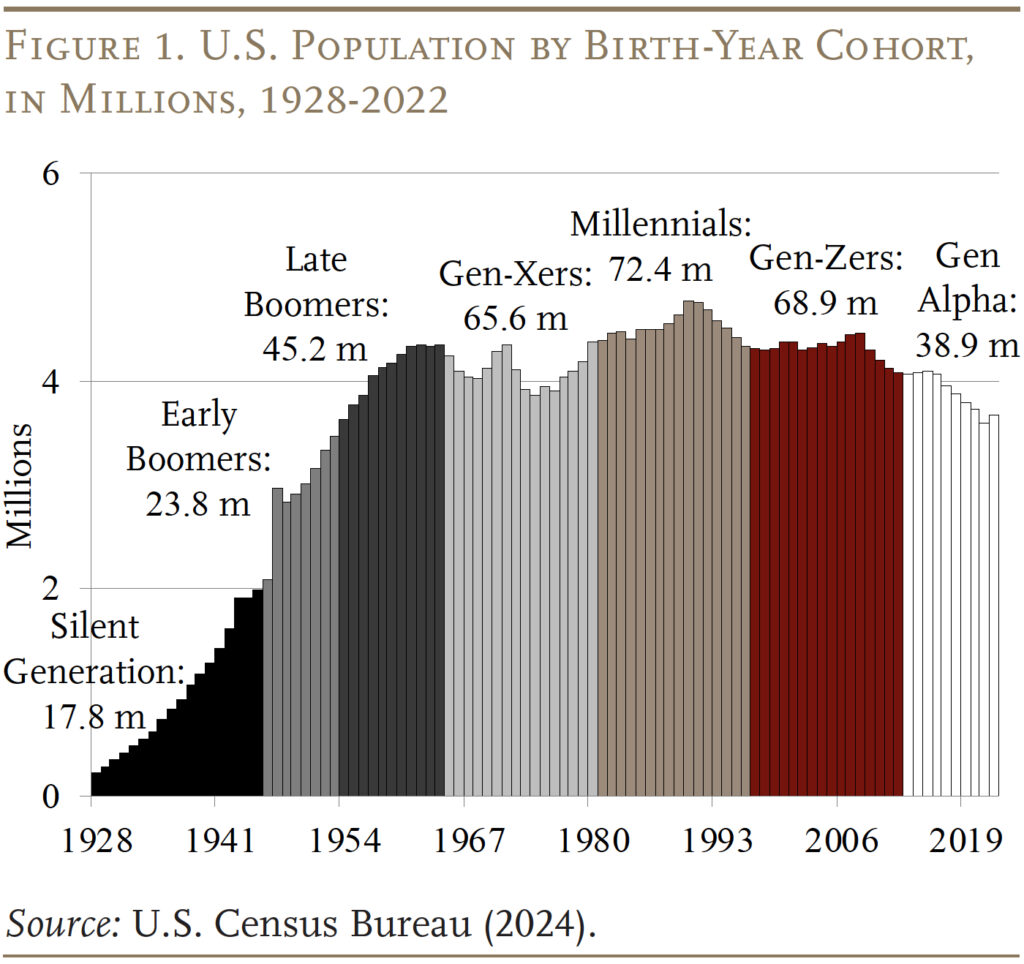
The main focus right here, and in our prior collection, is on the section of Millennials who have been ages 31-41 in 2022, which implies these born from 1981-91. These people are in comparison with Gen-Xers and Late Boomers once they have been the identical ages. The Gen-Xers have been the identical ages in 2010 (which covers these born from 1969-79), and the Late Boomers have been the identical ages in 1995 (which covers these born from 1954-64).
Millennials are distinctive in quite a few methods. They have been the primary full era to develop up with computer systems. Social scientists are likely to characterize them as self-confident and optimistic since their dad and mom tended to be attentive and supportive.3 They’re additionally extra ethnically various than earlier cohorts; as proven in Determine 2, the share of Whites declined from 72 % of Late Boomers to 55 % of Millennials.

Millennials are additionally extra educated than earlier cohorts, with nearly half of ladies and 40 % of males having a school diploma, in comparison with solely 1 / 4 of Late Boomers and a 3rd of Gen-Xers (see Determine 3). One would count on that this increased degree of schooling would bode effectively for work, earnings, and wealth accumulation.
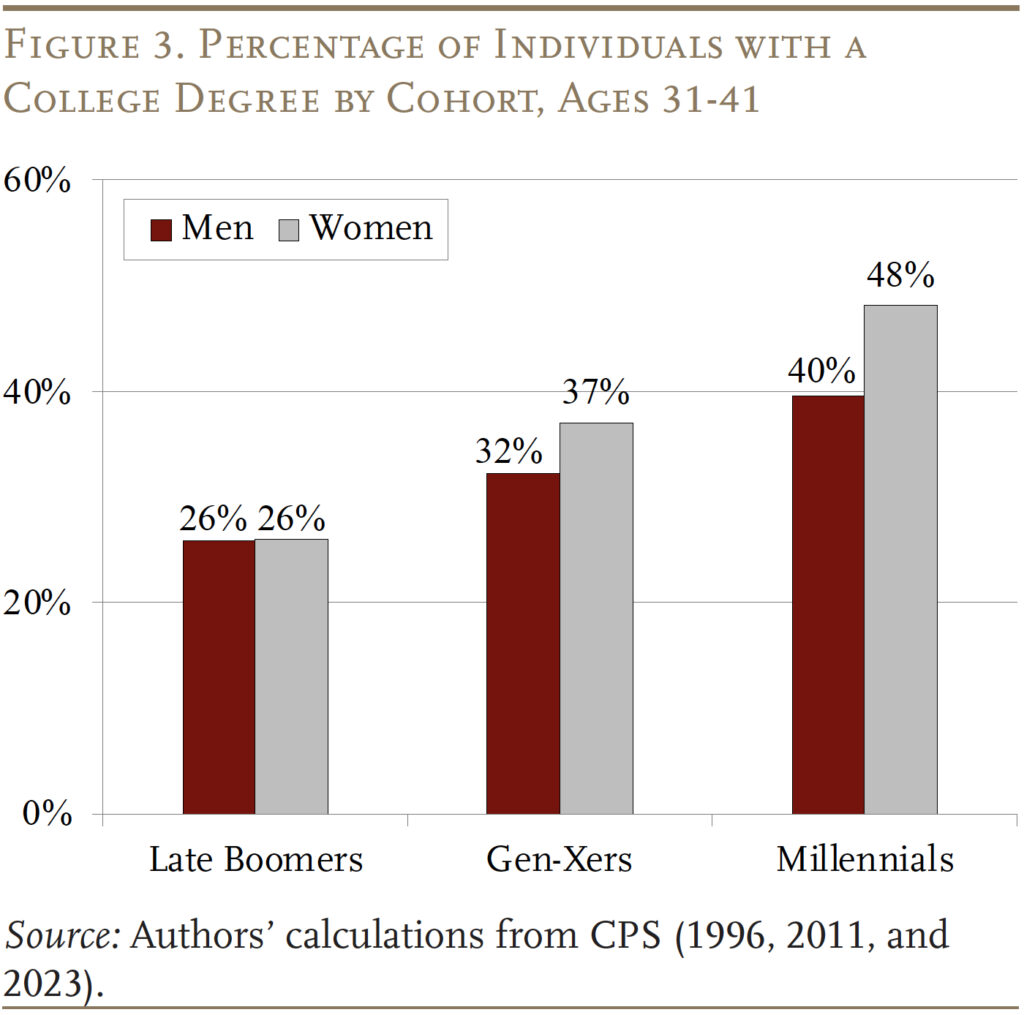
Sadly, as famous, Millennials entered the labor market throughout powerful instances.4 The group examined right here turned 21 between 2002 and 2012, which meant that they have been popping out of college throughout a interval that included the bursting of the dot.com bubble and the Nice Recession. This expertise was significantly laborious on Millennial males, who had labor drive participation charges under these in earlier cohorts.
In line with the 2019 replace, information for 2022 present that nearly all the sooner shortfall between Millennials and earlier cohorts in labor market exercise, marriage, and homeownership has disappeared (see Desk 1). Towards this background, the important thing query is what has occurred to the wealth of Millennials throughout and after the pandemic and the way they now examine to earlier generations once they have been the identical age.

Wealth Holdings by Cohort
In 2019, pre-pandemic, even if Millennials had caught up on many metrics, their wealth holdings nonetheless lagged considerably behind the accumulations of earlier cohorts, largely as a consequence of their excessive ranges of scholar loans. The low wealth of Millennials has been a supply of great concern on condition that they may stay longer – and must assist extra years of retirement than earlier cohorts – and that, with the rise in Social Safety’s Full Retirement Age to 67, they may obtain decrease advantages relative to pre-retirement revenue than earlier cohorts.
Information for 2022, nonetheless, present a dramatic reversal within the fortunes of Millennials (see Determine 4).5 The primary group of bars present the wealth-to-income ratios for these ages 28-38 in every cohort, at which level Millennials have been behind. Three years later, in 2022, when this group was 31-41, the sample had dramatically reversed, with Millennials pulling manner forward of earlier cohorts. Whereas Millennials are nonetheless extra prone to have scholar debt and the worth of their debt is increased (see Desk 2), clearly different components have greater than compensated for that burden.
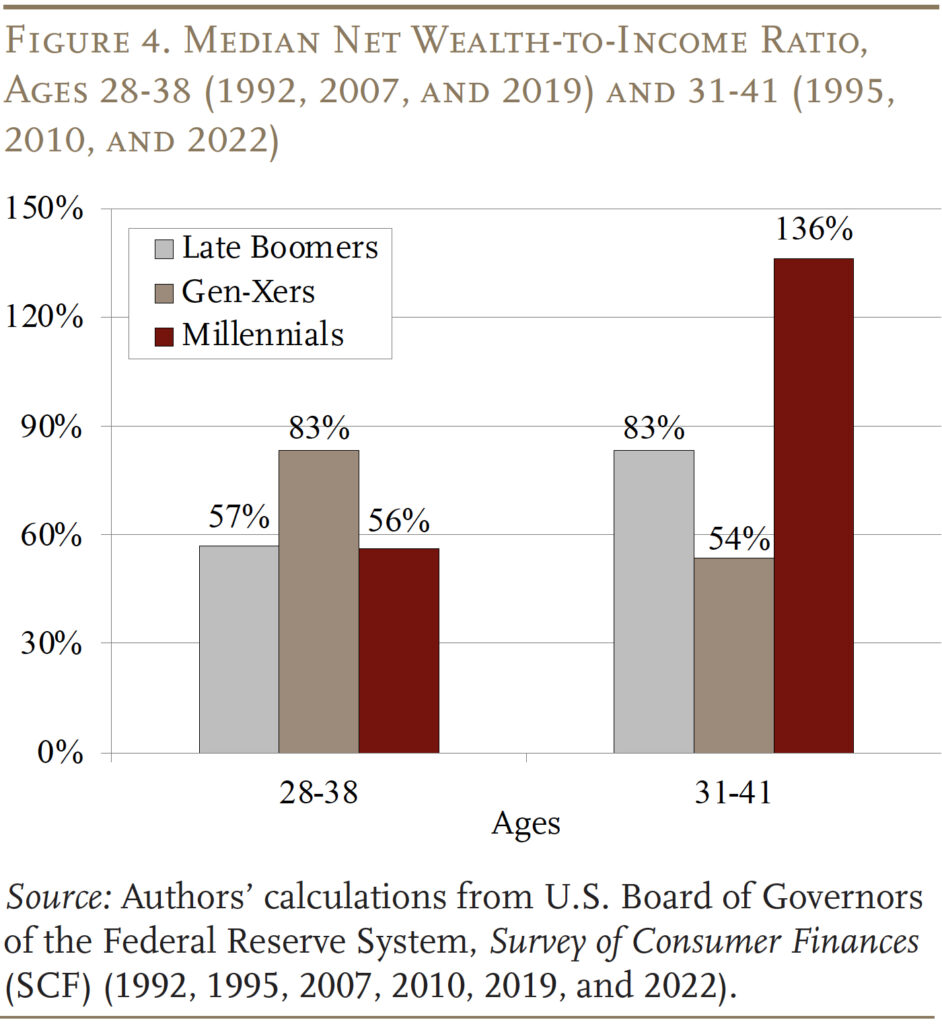
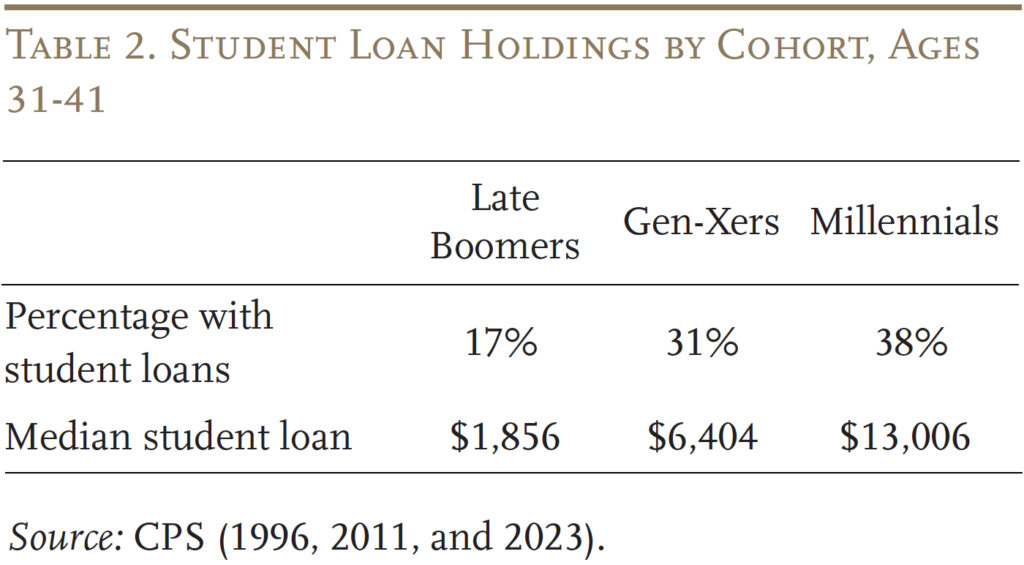
The relative beneficial properties of Millennials in wealth-to-income ratios must be interpreted with some warning. First, the success relative to Gen-Xers is slightly exaggerated as a result of Gen-Xers have been 31-41 in 2010, when fairness and home costs had been battered by the Nice Recession. Second, the wealth measure used on this evaluation excludes two main sources of retirement wealth: Social Safety and outlined profit pensions – each of which have been bigger for earlier cohorts.
On a extra constructive observe, the advance in wealth holdings amongst Millennials was not simply concentrated among the many rich, however reasonably occurred throughout the entire wealth distribution (see Determine 5). Strikingly, Millennials in every wealth group are higher off.
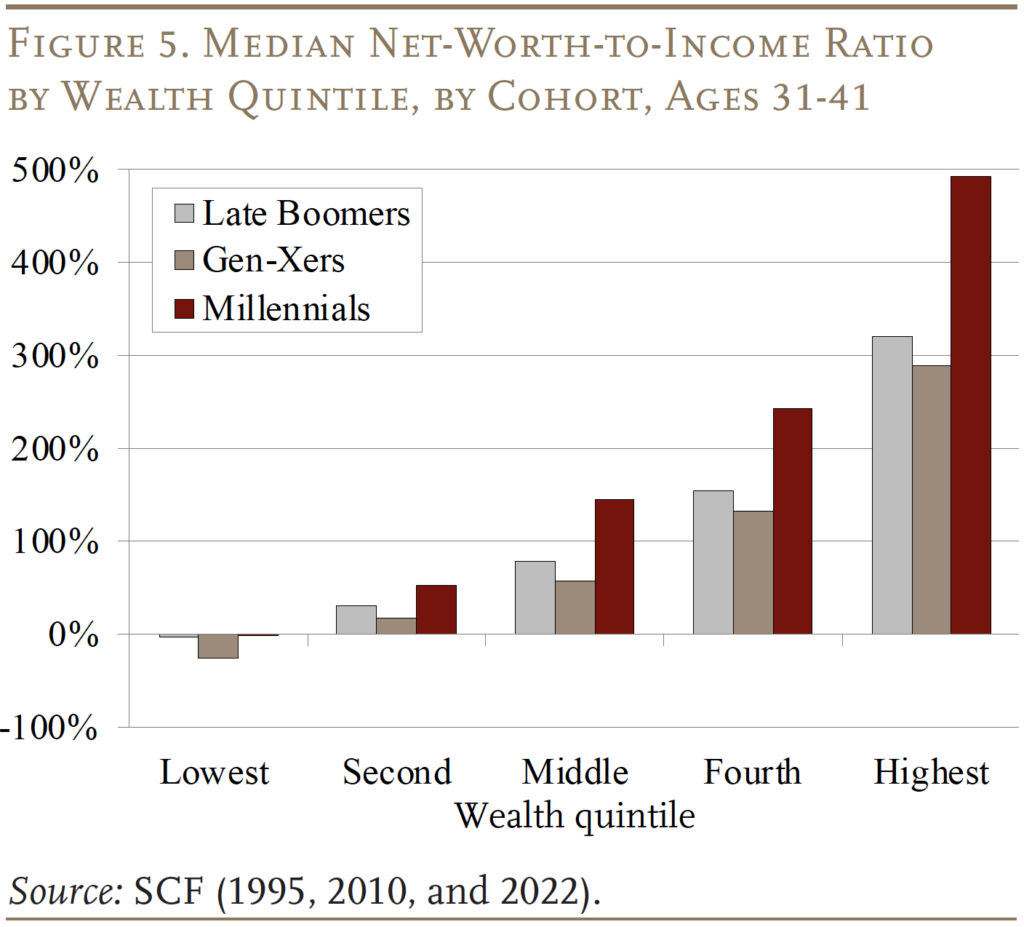
Supply of the Enchancment
Why did Millennials pull forward? Determine 6 breaks down the supply of the rise in median web value ($72,280) by part. A lot of the wealth acquire – 63 % – has come by way of housing, however monetary belongings have additionally elevated.
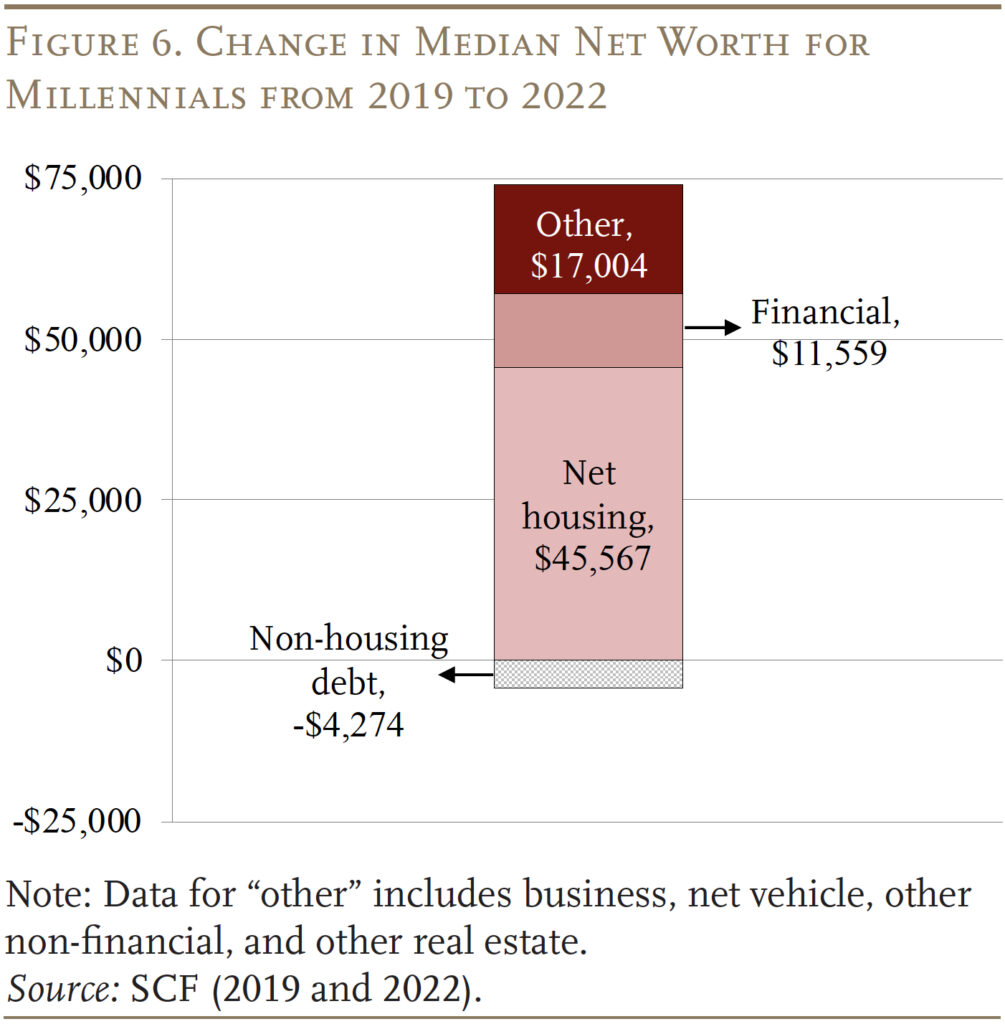
Housing Wealth
The rise in housing wealth displays the dramatic enhance in home costs that occurred in the course of the pandemic (see Determine 7). When fascinated by retirement saving, nonetheless, it’s not clear methods to assess housing wealth. The home is an illiquid asset, and few folks reap the benefits of their dwelling fairness to assist their consumption in retirement.6 Reasonably they have an inclination to carry their housing fairness in reserve to cowl any long-term care wants towards the top of life or to go away as a bequest to their kids. Furthermore, present dwelling costs are about 16 % above their pattern during the last 30 years and will effectively revert again to the pattern over time.
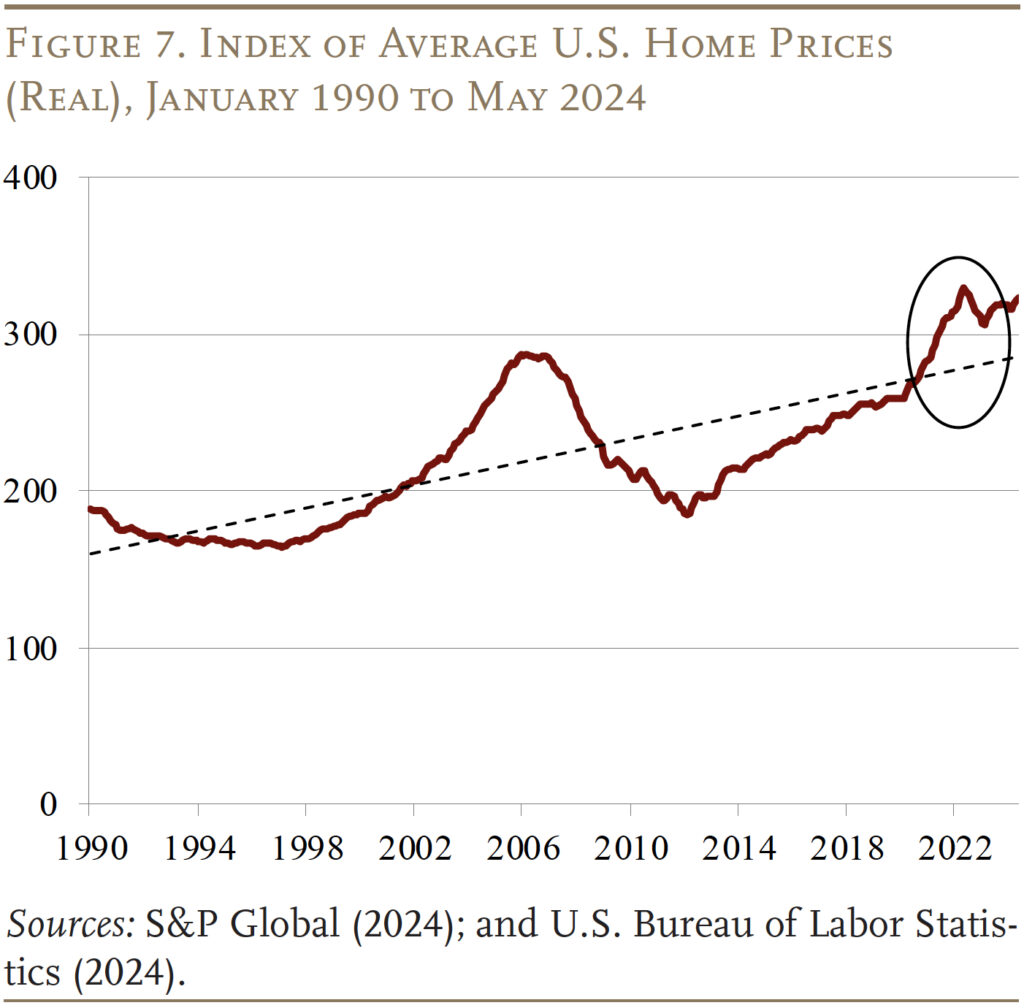
Not all Millennials have loved the pandemic housing market increase. Millennial renters pay a better share of revenue for housing prices than prior generations, and the costly housing market could imply they may have a tougher time turning into owners and having fun with future beneficial properties within the housing market.
Monetary Wealth
Regardless that housing wealth is the primary cause Millennials are doing comparatively higher than older cohorts, they’re additionally forward on monetary belongings (see Determine 8). This enchancment displays each elevated saving and a run-up in fairness costs.
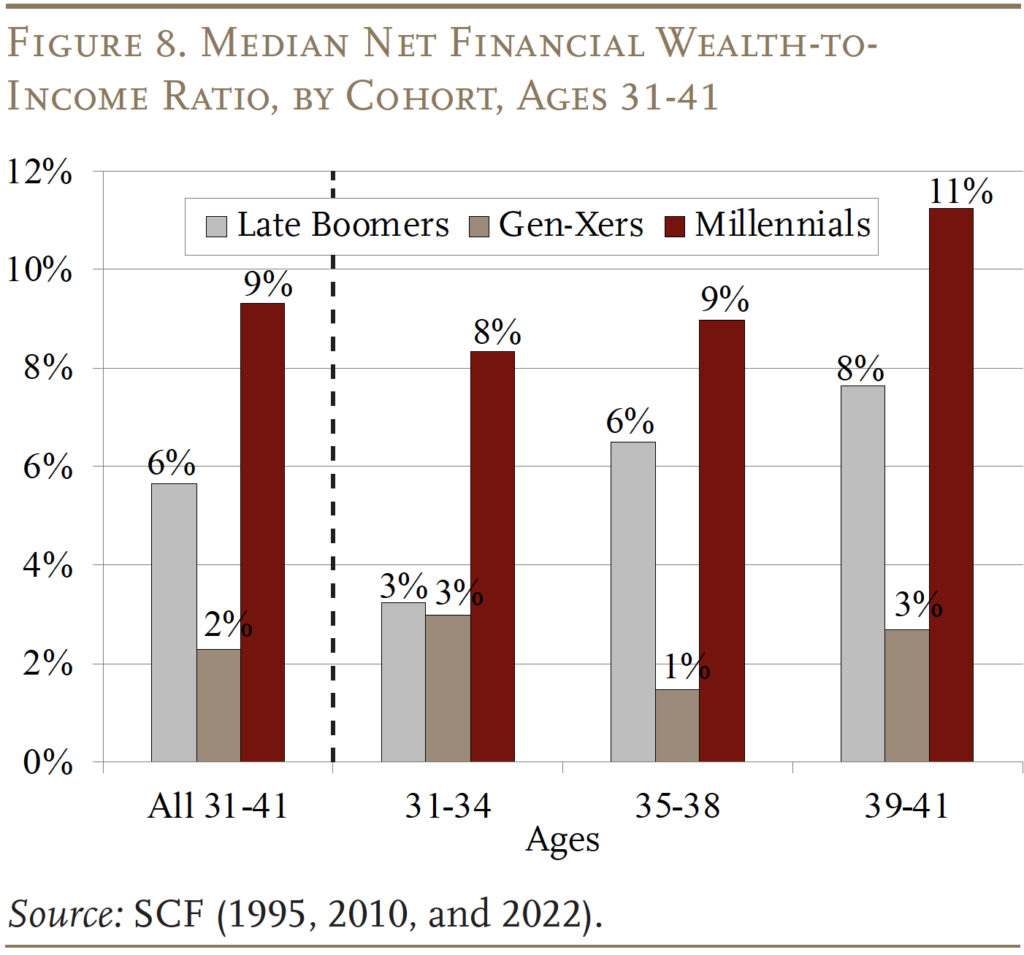
Fueled by the federal stimulus spending and scholar mortgage pause, private financial savings jumped to over 30 % in the course of the first two years of the pandemic (see Determine 9). All households, together with the Millennials, have been capable of construct up financial savings and make their stability sheets stronger. Millennials, nonetheless, usually tend to be in two-earner households, have increased family incomes, and fewer children – all of which offers extra room for financial savings on prime of stimulus checks (see Desk 3).

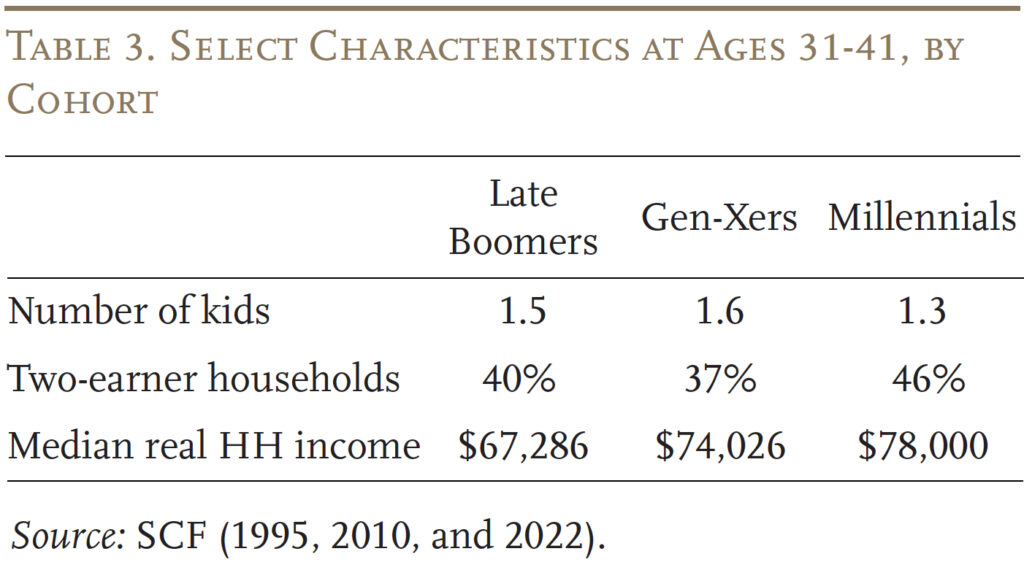
Equally, whereas all cohorts profit from a rising inventory market, Millennials are additionally extra prone to spend money on shares. Over 60 % of Millennials maintain some equities, primarily of their retirement accounts, in comparison with 48 % of Gen Xers and 37 % of Late Boomers on the identical ages. Moreover, near 1 / 4 of Millennial households maintain shares outdoors of their retirement accounts – roughly twice the share of earlier cohorts.7 On account of their broad holdings in equities, they have been well-situated to learn from a powerful inventory market (see Determine 10).
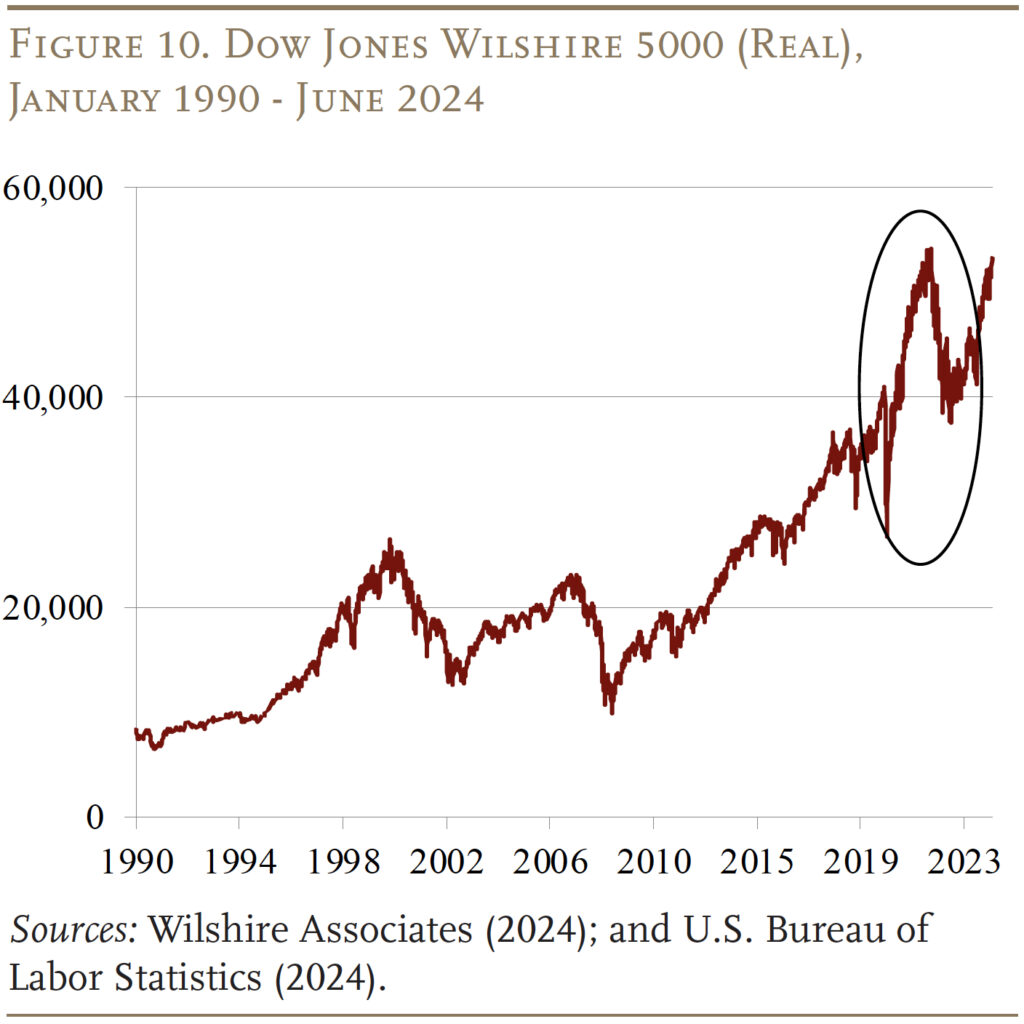
Conclusion
Millennials now have extra web wealth relative to revenue of their 30s than Gen Xers and Late Boomers had, regardless of nonetheless having extra scholar debt. A lot of the enchancment of their stability sheets is as a result of speedy enhance in housing costs in the course of the pandemic. Additionally they have increased non-housing wealth as effectively, due to elevated saving and being positioned to revenue from a powerful inventory market.
Regardless of all of the enhancements, the great fortune of the Millennials depends totally on housing. The home is an illiquid asset, and few folks reap the benefits of their dwelling fairness to assist their consumption in retirement. Therefore, it’s not clear the extent to which housing fairness must be counted as retirement saving.
References
Chen, Anqi and Alicia H. Munnell. 2021. “Millennials’ Readiness for Retirement.” Concern in Transient 21-3. Chestnut Hill, MA: Heart for Retirement Analysis at Boston Faculty.
Harris, Malcolm. 2017. Youngsters These Days: Human Capital and the Making of Millennials. Boston, MA: Little, Brown and Firm.
Hernandez Kent, Ana and Lowell R. Ricketts. 2024. “Millennials and Older Gen Zers Made Vital Wealth Features in 2022.” On the Economic system Weblog (February 24). St. Louis, MO: Federal Reserve Financial institution of St. Louis.
Johnson, Richard W. and Karen E. Smith. 2024. “How Gloomy is the Retirement Outlook for Millennials?” In Actual-World Shocks and Retirement System Resiliency, edited by Olivia S. Mitchell, John Sabelhaus, and Stephen Utkus. New York, NY: Oxford College Press.
Howe, Neil and William Strauss. 2000. Millennials Rising: The Subsequent Nice Era. New York, NY: Classic Books.
Munnell, Alicia H. and Wenliang Hou. 2018. “Will Millennials Be Prepared for Retirement?” Concern in Transient 18-2. Chestnut Hill, MA: Heart for Retirement Analysis at Boston Faculty.
Pinsker, Joe and Veronica Dagher. 2024. “The Dramatic Turnaround in Millennials’ Funds.” (August 13). New York, NY: The Wall Road Journal.
S&P World. 2024. “S&P CoreLogic Case-Shiller U.S. Nationwide Residence Value NSA Index.” New York, NY: S&P Dow Jones Indices.
Tolentino, Jia. 2017. “The place Millennials Come From.” (December 4). New York, NY: The New Yorker.
Twenge, Jean M. 2014. Era Me-Revised and Up to date: Why At this time’s Younger People Are Extra Assured, Assertive, Entitled – and Extra Depressing Than Ever Earlier than. New York, NY: Simon and Schuster.
U.S. Board of Governors of the Federal Reserve System. Survey of Client Funds, 1992, 1995, 2007, 2010, 2019, and 2022. Washington, DC.
U.S. Bureau of Financial Evaluation. 2024. “Private Saving Price Information (accessed from FRED database).” Washington, DC.
U.S. Bureau of Labor Statistics. 2024. “Client Value Index.” Washington, DC.
U.S. Census Bureau. Present Inhabitants Survey, 1996, 2011, and 2023. Washington, DC.
U.S. Census Bureau. 2024. “Nationwide Inhabitants by Traits: 2020-2023.” Washington, DC.
Wilshire Associates. 2024. “Dow Jones Wilshire 5000 (Full Cap) Value Ranges Since Inception.” Santa Monica, CA. Information for Nominal Greenback Ranges.

